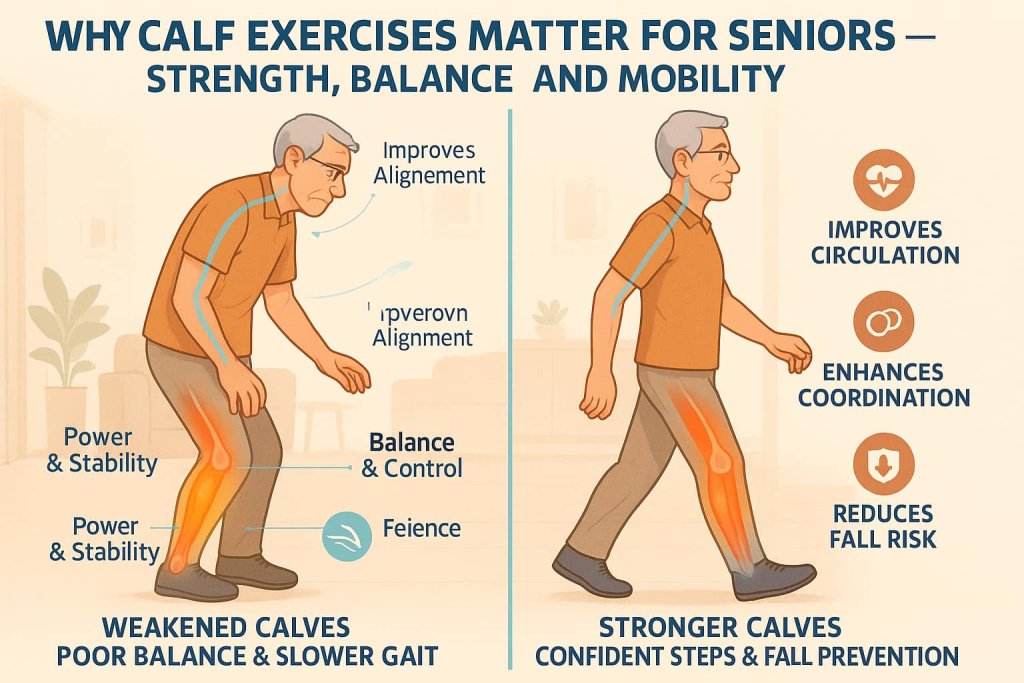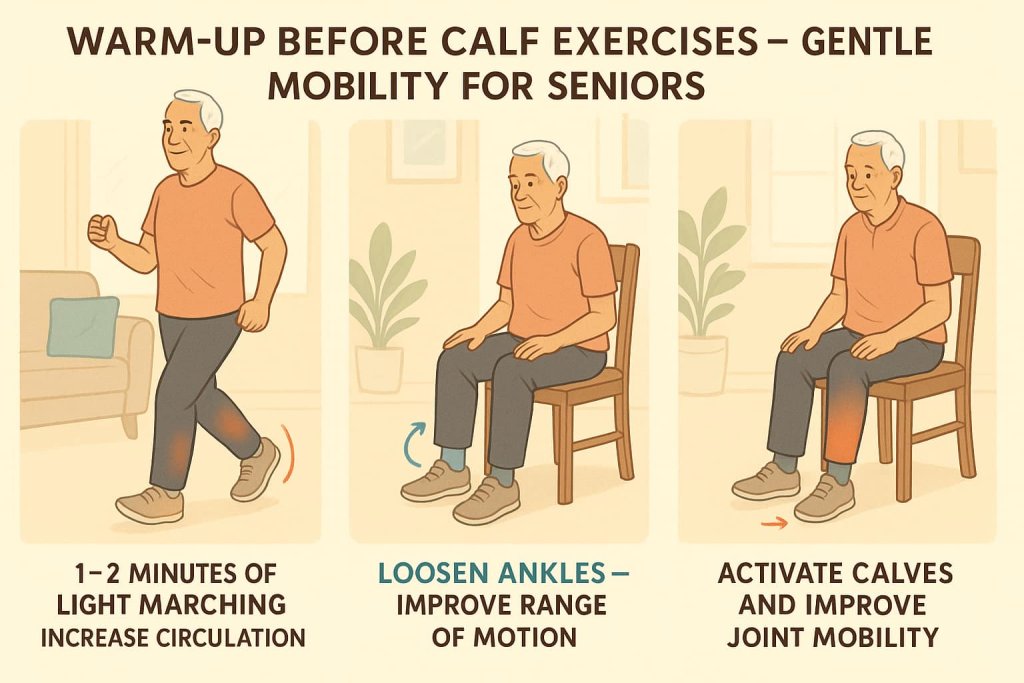Strong calves are essential for seniors to maintain balance, prevent falls, and walk confidently.
Calf exercises strengthen the gastrocnemius and soleus muscles, improve ankle mobility, and enhance circulation — all key to staying active and independent. Whether standing or seated, these gentle, low-impact movements can be done safely at home with or without equipment.

Maintaining lower-leg strength supports posture, stability, and everyday activities like climbing stairs, getting up from a chair, and walking on uneven ground. According to the CDC’s “Growing Stronger” program, toe-stand (heel-rise) exercises are recommended for improving lower-body function in older adults.
Why Calf Exercises Matter for Seniors
With age, the muscles in the lower legs naturally weaken, reducing balance and gait speed. Research from Frontiers in Physiology (2023) shows that targeted calf training helps preserve muscle power and coordination — two key predictors of fall prevention.

Calf exercises help:
- Strengthen the gastrocnemius and soleus for better balance
- Improve blood flow and reduce swelling in the lower legs
- Support safer walking and posture
- Maintain mobility and confidence in daily movement
Warm-Up Before You Start

Always warm up gently for 5–10 minutes before exercising:
- March in place or walk slowly
- Perform light ankle circles
- Do seated leg extensions or heel taps
This increases circulation and prepares your muscles for movement.
10 Best Calf Exercises for Seniors
These gentle yet effective calf exercises help seniors build lower-leg strength, boost balance, and maintain confident mobility.
Do them regularly to improve circulation, prevent falls, and support everyday movements like walking, climbing stairs, and standing tall.
1. Standing Calf Raise
Why it works:
This foundational movement strengthens the entire calf complex and enhances balance during standing and walking. By lifting your body weight through your toes, you activate both the gastrocnemius and soleus, improving push-off strength and circulation in the lower legs — crucial for maintaining stability as you age.
Muscles worked:
Gastrocnemius, Soleus, Tibialis Posterior
How to do it:
- Stand behind a sturdy chair or countertop, hands resting lightly for balance.
- Keep your feet hip-width apart and posture tall.
- Rise slowly onto the balls of your feet, lifting your heels off the ground.
- Hold the top position for 2–3 seconds, then lower your heels back down slowly.
- Perform 10–15 reps for 2–3 sets.
Trainer Tip:
Move slowly and focus on the squeeze at the top — this improves muscle activation and reduces strain on the Achilles tendon.
2. Seated Calf Raise
Why it works:
A joint-friendly option for seniors, this exercise isolates the soleus muscle, which plays a major role in ankle stability. It can be done while seated, making it ideal for anyone with balance issues or knee discomfort.
Muscles worked:
Soleus, Lower Gastrocnemius
How to do it:
- Sit upright in a sturdy chair with both feet flat on the floor.
- Slowly lift your heels while keeping toes grounded.
- Hold the contraction for 2 seconds, then lower your heels to the floor.
- Repeat 15–20 reps for 2–3 sets.
Trainer Tip:
For added resistance, place a book, backpack, or light dumbbell on your thighs.
3. Toe Walks
Why it works:
Walking on your toes challenges your calves dynamically, improving muscular endurance, ankle control, and gait stability. This movement also helps maintain coordination during everyday activities like climbing stairs or walking uphill.
Muscles worked:
Gastrocnemius, Soleus, Intrinsic Foot Muscles
How to do it:
- Stand tall and rise onto your toes.
- Walk forward 10–15 steps while keeping your heels off the ground.
- Rest briefly, then repeat 2–3 rounds.
Trainer Tip:
If balance is limited, perform this next to a wall or counter for extra support.
4. Heel Walks
Why it works:
A great complement to toe walks, heel walks strengthen the muscles on the front of your lower legs, improving foot lift and reducing the risk of tripping. It also enhances overall ankle control and coordination.
Muscles worked:
Tibialis Anterior, Gastrocnemius (stabilization), Foot Flexors
How to do it:
- Stand with feet hip-width apart.
- Lift your toes off the floor so only your heels touch.
- Walk forward 10–15 steps, keeping toes elevated.
- Repeat for 2–3 sets.
Trainer Tip:
Alternate toe and heel walks for balanced lower-leg training and improved mobility.
5. Wall Calf Stretch
Why it works:
Stretching the calves helps relieve tension, improve ankle mobility, and reduce stiffness that often builds up from prolonged sitting or walking. Enhanced flexibility supports smoother, safer movements.
Muscles worked:
Gastrocnemius, Soleus
How to do it:
- Stand facing a wall, one foot forward and one back.
- Keep your back leg straight with the heel flat on the floor.
- Press your hips gently toward the wall until you feel a stretch in your calf.
- Hold for 20–30 seconds, switch sides, and repeat.
Trainer Tip:
Perform this stretch daily — especially after walks or workouts — to maintain mobility and prevent muscle cramps.
6. Step Calf Raise
Why it works:
By allowing your heels to drop below step level, this variation increases the range of motion and provides a deep stretch and stronger contraction for both major calf muscles.
Muscles worked:
Gastrocnemius, Soleus, Foot Stabilizers
How to do it:
- Stand on a sturdy step or low stair with your heels hanging off the edge.
- Hold a railing or wall for support.
- Rise onto your toes, pause, then slowly lower heels below step level.
- Perform 10–12 reps for 2–3 sets.
Trainer Tip:
Avoid rushing the lowering phase — the eccentric motion (lowering) is where most of the strength gains occur.
7. Single-Leg Calf Raise (Advanced Option)
Why it works:
This advanced balance challenge strengthens each leg individually, correcting muscle imbalances and improving ankle stability for better walking mechanics.
Muscles worked:
Gastrocnemius, Soleus, Peroneals, Intrinsic Stabilizers
How to do it:
- Stand near a wall or chair for balance.
- Lift one foot slightly off the floor.
- Slowly rise up on the standing leg’s toes, hold for 2 seconds, and lower with control.
- Perform 8–10 reps per leg, for 2–3 sets.
Trainer Tip:
Start with both legs together, then transition to single-leg raises as your strength and confidence grow.
8. Seated Toe Taps
Why it works:
Promotes circulation and strengthens the front of your lower legs, which helps with ankle dorsiflexion — essential for smooth, controlled walking. It’s an excellent exercise for seniors who sit for long periods.
Muscles worked:
Tibialis Anterior, Soleus (stabilization)
How to do it:
- Sit upright with feet flat on the floor.
- Keep your heels down and lift your toes toward your shins.
- Tap your toes gently 15–20 times, rest, and repeat for 2–3 sets.
Trainer Tip:
Alternate between seated calf raises and toe taps to strengthen both sides of your lower leg.
9. Resistance Band Calf Press
Why it works:
Provides resistance without added weight, helping to safely build calf strength and joint control. Perfect for seniors who want low-impact resistance training at home.
Muscles worked:
Gastrocnemius, Soleus, Tibialis Posterior
How to do it:
- Sit on the floor with legs extended.
- Loop a resistance band around the balls of your feet.
- Push your toes forward to stretch the band, then slowly return.
- Repeat 10–15 reps for 2–3 sets.
Trainer Tip:
Maintain slow, steady tension on the band to keep muscles under constant load and improve control.
10. Ankle Circles
Why it works:
Encourages circulation, lubricates the ankle joint, and maintains mobility — especially helpful for seniors dealing with stiffness or swelling.
Muscles worked:
Calf Stabilizers, Foot Flexors and Extensors
How to do it:
- Sit tall or recline slightly with legs extended.
- Lift one foot and rotate it in a circle 10 times clockwise, then 10 times counterclockwise.
- Switch sides and repeat for 2–3 sets.
Trainer Tip:
Perform this as a gentle warm-up or cooldown to keep your ankles loose and healthy throughout the day.
Safety & Precautions for Seniors
- Always hold onto a stable surface for balance.
- Avoid bouncing or fast, jerky motions.
- Stop immediately if you feel sharp pain or dizziness.
- Consult a healthcare professional if you have neuropathy, arthritis, or balance disorders before starting new exercises.
Programming Tips
- Frequency: 3–4 times per week
- Reps/Sets: 10–20 reps, 2–3 sets per move
- Rest: 30–60 seconds between sets
- Progression: Increase repetitions or resistance gradually
FAQs About Calf Exercises for Seniors
1. How often should seniors train their calves?
Aim for 3–4 times per week to maintain strength and balance.
2. Can these exercises be done seated?
Yes — seated calf raises and toe taps are excellent options for limited mobility.
3. Are calf stretches important for seniors?
Absolutely. Stretching reduces stiffness, improves mobility, and prevents cramps.
4. What’s the best time to do these exercises?
Anytime — but ideally after a light warm-up or short walk.
5. Can calf training help prevent falls?
Yes. Strong calves improve ankle control, posture, and overall stability.
6. Do I need special equipment?
No. Most can be done with bodyweight, a chair, or a resistance band.
7. Are calf exercises safe for seniors with arthritis?
Generally, yes — as long as movements are slow and pain-free. Always consult a doctor if uncertain.
Conclusion
Calf exercises are simple yet powerful tools to help seniors stay steady, mobile, and independent. By strengthening these often-neglected muscles, you’ll improve your walking confidence and protect against falls.
Start today with 10–15 minutes of calf training — small daily steps lead to lasting leg strength and balance.
This content is for informational purposes only and not medical advice.
References
- Ema et al., 2017 — Home-Based Calf-Raise Training in Older Men
Improved plantar-flexor rapid force and neuromuscular function with progressive calf raises done at home.
PMC - André et al., 2020 — Calf-Raise Senior (CRS) Test
Field test to track ankle/calf function in older adults; useful for gauging progress from your program.
PLOS - CDC — Physical Activity Guidelines for Older Adults (2023 page)
Authoritative U.S. guidance: include muscle-strengthening and balance activities weekly.
CDC - CDC — Growing Stronger Program (Toe-Stand/Heel-Rise Included)
Step-by-step strength plan for older adults; includes heel-rise (calf raise) instructions.
CDC - Cochrane Review, 2019 — Exercise to Prevent Falls (Community-Dwelling Older Adults)
High-quality evidence that multicomponent programs (balance + strength) reduce falls.
Cochrane Library - Sherrington et al., 2020 — PubMed Summary of Fall-Prevention Effects
Quantifies reductions in fall rates (e.g., ~24% with balance/functional training; ~34% with multicomponent).
PubMed
